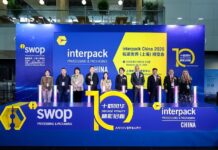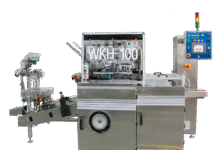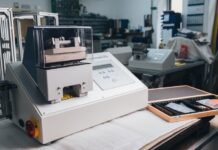
‘No compromising on product safety’ is the overriding principle for companies of the pharmaceuticals industry and for allied enterprises in the packaging sector. Owing to their high responsibility for human health, they are strictly monitored and have to observe numerous specifications and guidelines, a feat that can be quite challenging. From an economic point of view, this sector can still take pleasure in a market experiencing stable growth. The German pharmaceuticals market leads the field within Europe and, with annual sales of over EUR 50 billion in 2015, occupies fourth place globally. But, even in this sector, the industry has to keep pace with the changing market dynamics.

form to pharmacies, who packaged
the medication in portions for
patients. Photo Bayer
Rising life expectancy, the increase in chronic diseases and the introduction of new and often very expensive forms of treatment have been responsible for strong growth in the last few years. More and more diseases are becoming treatable. Even for rare disorders with relatively small numbers of cases, more and more medicines are being developed for which manufacturers are called upon to achieve greater complexity with ever smaller batch sizes. There is a trend away from standardization and towards individualized treatment. For plant manufacturers and packaging system suppliers, the high flexibility and rapid retooling
already demanded in the market is thus intensifying further.
For such requirements, Medipak Systems, a member of the Körber Group, offers its customers solutions that it conceives as modular, scalable platforms and gives manufacturers the necessary scope for manufacture in smaller batches and using different packages. “Our customers’ investment in production and packaging processes is immense. They require solutions that can be used for a large variety of products, can be quickly retooled and are capable of extension over their life-cycle,” explains Clemens Berger, the company’s chief executive officer.

to rapid availability and practical
removal in the design of medicine
packages. Photo Bayer
In the future of Industry 4.0, single machines or stand-alone solutions will no longer be sufficient. Only integrated systems that take the entire value chain into account can compete in the market in the long term. The customer wants to reduce his cost per package over the entire process, and this calls for improvements in overall plant effectiveness from suppliers. Reliable plant availability is all-important here along with high machine performance and continuously high production quality.
Growth in the pharmaceuticals sector is being offset by cost reductions in the health systems in many countries with price ceilings, mandatory discounts, and benefit-based pricing or reimbursement models. There is also an increase worldwide in regulatory requirements imposed by supervisory authorities. For medicine manufacturers and packagers, this places still higher demands on the process chain as a whole.
At the same time, there is growth in the market for generic drugs, whose active ingredients are identical to those of the original preparations but are sold at much lower prices. This competition encourages efficient technologies and processes to compensate for the high pressure on costs in the generic pharmaceuticals market.
Innovation in packaging design

safety in the pharmaceuticals sector.
Photo Uhlmann
New, innovative packaging concepts are being developed despite, or precisely because of, the competition from generic drugs. The introduction of the new Aspirin generation in 2014, when the Bayer Group decided to develop its classic packaging further, is an example of the most recent past. Few medicines can look back on such a long tradition; this well-known painkiller has been holding its own in the marketplace for over 115 years now. In cooperation with the Romaco Group, it has developed a new packaging technology that is adapted to consumers’ changing needs. For this, the tablets are individually sealed and
perforated—in the shape of a four-leafed clover. The pouches concerned consist of an aluminium or paper laminate protecting the individual tablets effectively from such external influences as light and moisture. In the design, importance has been attached to easy access—an argument that is becoming increasingly compelling in view of the growing elderly proportion of the population in the industrialized nations.
At interpack 2017 in Düsseldorf from 4 to 10 May 2017, visitors can find out about the innovative developments in the packaging sector to meet the growing demands resulting from legal provisions and consumer needs. Interesting insights into the latest production technology will also be afforded by the accompanying ‘components – special trade fair by interpack’. This is targeted primarily at suppliers to the packaging industry and at companies offering drive, control and sensor technology, products for industrial image processing, handling equipment, industrial software and communication, and complete automation systems for packaging machines.
Smart packaging

The fact that patient leaflets in a medicine package do not always have to be in printed form is illustrated by the latest further developments in packaging technology, now made possible for the first time by near-field communication (NFC). Facilitating cashless payment and keyless vehicle entry, NFC is already familiar in everyday life. With the widespread use of smartphones the world over, contactless and wireless short-distance data exchange has also become of interest to the packaging sector. The possible applications range from reading out the patient leaflet and the automatic re-ordering of drugs through to more detailed information.
Under the generic term ‘smart packaging,’ the development of printed electronics is also rapidly advancing. Conductive plastics, inks on film, foil, paper or glass in combination with extremely thin, flexible and transparent electronic components—plus interactive displays, luminous effects and sensors—are already converting today’s packages into high-tech products. In the future, smart packages will satisfy virtually all wishes and will have to be an integrated part of an overall eHealth strategy. Smart packages understand the patient’s personal dosage, make the right medicine available at the right time with the aid of time-controlled access and sound an alarm when drug intake is skipped. These are innovations
that are capable of improving patient safety.
Top priority for patient safety
Another global challenge for the sector is the problem of product piracy. The worldwide trade in counterfeit medicines is a multi-million dollar business that causes considerable loss for the pharmaceuticals industry and, more importantly, puts the health of numerous people at risk. A joint goal of the packaging and pharmaceuticals industry must therefore be to prevent the distribution of counterfeit medicines.
Stricter guidelines and better product identification are essential for the protection of the patient. In many countries, these are already being implemented or are on the brink of being so. An example is the Commission Delegated Regulation (EU) 2016/161 of the European Union with binding provisions against the entry of falsified medicines into the legal supply chain. It states that all prescription medicines must be provided with unique identifiers and an anti-tampering device.

processing of personalized biotech products that have
to be produced aseptically and therefore require special technologies. Photo Medipak Systems
Specifically, this arrangement means that the medicines concerned must be marked from February 2019 with an individual serial number and be clearly undamaged—a challenge that pharmaceuticals companies and packaging manufacturers took up years ago. Uhlmann-Pac-Systeme GmbH & Co. KG has been concerned with the complex issue of serialization since 2005 and, in the face of these challenges, has evolved into a supplier of complete solutions. Updates, new software versions and the associated advice are integral elements of today’s business. “The fact that serialization has an impact on many processes throughout the company should not be underestimated. This is where project leaders have to drive genuine change management,” explains Kathrin Günther, responsible for the sale of software and automation solutions at Uhlmann.
Many manufacturers are resorting not only to identification, but also to the continuous traceability of their products with the aid of integrated track-and-trace solutions. In this
area, the company offers a variety of print technologies and the possibility of label application, intelligent inspection systems, and printing and marking solutions. Depending
on the requirement, the components can be combined and even integrated in machines and plants in operation.
In terms of piracy-proof features, the solutions of plant manufacturers are varied. Holograms, synthetic DNA and laser codes, and special printing inks are in some cases
undetectable with the naked eye. The tamper-proof seal, or the tamper evidence label, can be attached to the medicine package or bonded on after product filling.
Rondo, a company of the Medipak Systems Group, does entirely without safety labels and adhesives. During the closure process, punch-outs on the base and lid flaps are activated to clearly and irreversibly indicate opening. The consumer can thus see at first glance whether the package has already been opened. The pack is opened and closed just as simply and easily as a conventional folded box. Another advantage is that the blanks can be processed without restrictions on existing packaging lines.
By the end of 2018, it is expected that over 75% of all prescription drugs worldwide will be protected by laws of this kind and their implementation will thus become crucial for the entire supply chain. In addition to patient and product safety, the new pharmaceuticals packages also improve the situation for the pharmaceuticals companies themselves. This is because the unique identifiability of a single medicine can considerably reduce the workload incurred by return deliveries and recalls.
Emotional appeal at the POS
Pharmaceuticals packages have to not only meet the complex needs and constraints of technology and safety, but also win through at the point of sale against a host of competing products. This applies particularly to over-thecounter medicines, although the competitive pressure among prescription drugs has risen significantly due to the increase in generics. Design and brand presentation make the difference here. Much like other consumer packages, the medicine package must also appeal directly to consumers, stimulate their emotions and precisely meet their needs. For brand recognition, package suppliers use consistent designs that present all the products of a manufacturer as a uniform block on the product shelf and thus stand out from the various competition items. The purchaser’s attention is held by plain language, unambiguous navigation with the aid of the design, and text arrangements without off-putting pharmaceutical jargon.
In the last few years, the drugs packaging industry has successfully accepted the various challenges in the pharmaceuticals sector and devised suitable strategies for this highly specialized business. Thanks to its huge capacity for innovation, the supply industry to the former ‘pharmacy of the world’ is also well equipped for the future.











